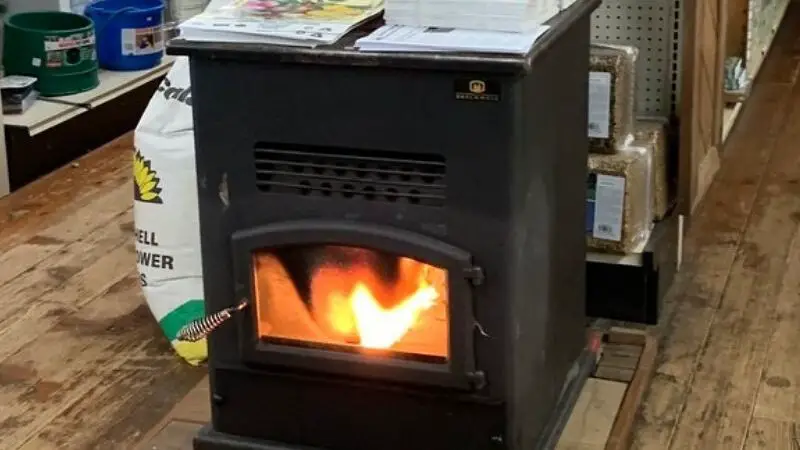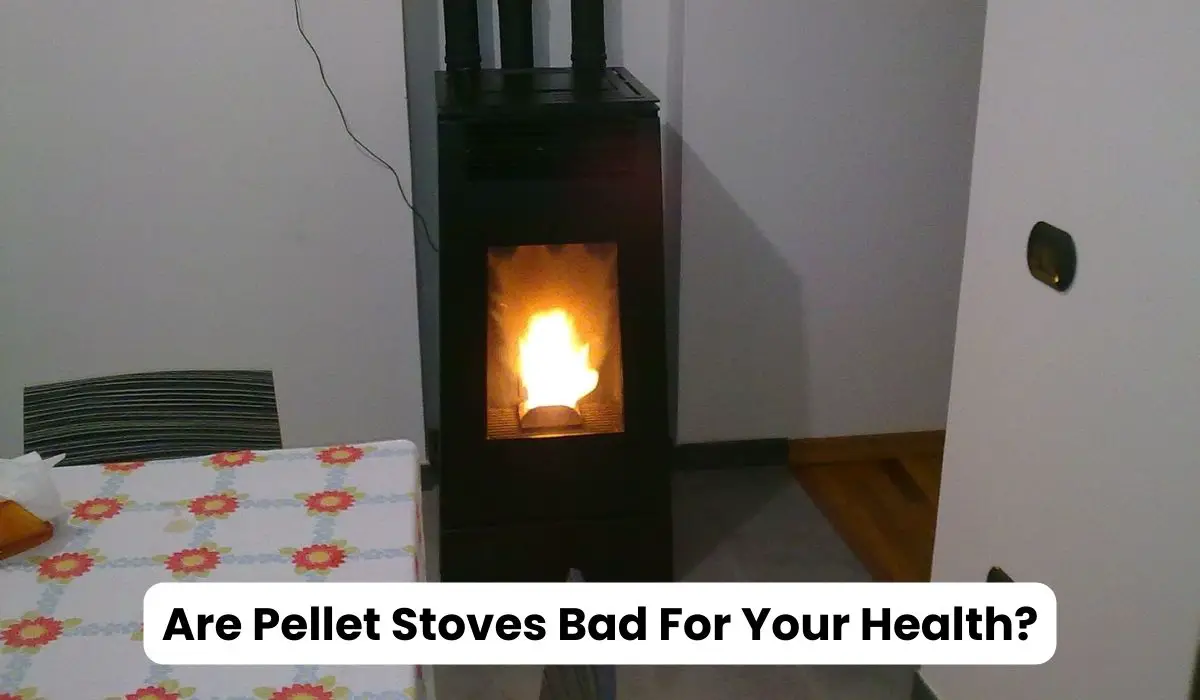Are pellet stoves bad for your health? As winter approaches and the chill settles in, many homeowners turn to pellet stoves for warmth and comfort. These compact and efficient heating devices have gained popularity for their eco-friendly reputation and cost-effectiveness.
However, beneath their cosy allure lies a lingering question: are pellet stoves truly safe for indoor air quality and overall health? While they offer an appealing alternative to traditional wood-burning stoves, concerns have arisen regarding their impact on respiratory health and air pollution.
In this article, we delve into the facts, myths, and potential health implications associated with pellet stoves, shedding light on a topic that affects countless households worldwide.
So, Let’s start.
Table of Contents
How Do Pellet Stoves Work?

Pellet stoves have gained popularity in recent years as an efficient and eco-friendly alternative to traditional wood-burning stoves and fireplaces. But amidst their convenience and warmth, some concerns linger about their impact on health. Are pellet stoves bad for your health?
To understand this, let’s delve into how pellet stoves work. Unlike conventional wood stoves that burn logs, pellet stoves utilize compressed wood pellets as fuel. These pellets are typically made from sawdust, wood shavings, or other biomass materials, which are tightly compressed into small, dense pellets.
The magic happens in the combustion chamber of the pellet stove. When you ignite the pellets, they burn cleanly and efficiently, producing heat and a minimal amount of smoke. Unlike traditional wood-burning stoves, which can release harmful pollutants like particulate matter and carbon monoxide into the air, pellet stoves are designed to minimize emissions and maximize efficiency.
One of the key components that contribute to the cleaner burn of pellet stoves is the electronic igniter and combustion blower. The igniter automatically lights the pellets, while the combustion blower ensures that air circulates properly within the stove, helping to maintain optimal combustion conditions.
Moreover, many modern pellet stoves come equipped with advanced technologies such as thermostats and programmable settings, allowing users to regulate heat output and fuel consumption more efficiently.
In summary, while pellet stoves offer many benefits in terms of efficiency and convenience, it’s important to be aware of their potential impact on indoor air quality and health. By understanding how pellet stoves work and taking necessary precautions, you can enjoy the warmth and comfort they provide while minimizing any potential health risks.
Are Pellet Stoves Bad For Your Health?

Are pellet stoves bad for your health? It’s a question that many homeowners considering this heating option often ponder. Let’s explore the intricacies and potential health implications of using pellet stoves to warm and cosy your living space.
Pellet stoves, hailed for their efficiency and eco-friendliness, operate by burning compressed wood pellets as fuel. These pellets, typically made from recycled wood or agricultural waste, offer a renewable energy source that’s cleaner than traditional wood-burning stoves.
One of the primary concerns regarding pellet stoves revolves around indoor air quality. While pellet stoves produce less smoke and emissions compared to their wood-burning counterparts, they still release fine particulate matter and potentially harmful gases into the air.
Prolonged exposure to these pollutants can lead to respiratory issues, especially for individuals with asthma, allergies, or other sensitivities. Fine particulate matter, in particular, can penetrate deep into the lungs and exacerbate existing health conditions or contribute to the development of respiratory problems over time.
Furthermore, improper installation or ventilation of pellet stoves can increase the risk of indoor air pollution. Poorly maintained stoves or using low-quality pellets can also result in incomplete combustion, leading to higher emissions of pollutants.
However, it’s essential to note that the health risks associated with pellet stoves can be mitigated through proper maintenance and usage practices. Regular cleaning and inspection of the stove, chimney, and venting system can help ensure optimal performance and reduce emissions.
Choosing high-quality pellets with low moisture content is also crucial for efficient combustion and minimal emissions. Additionally, ensuring adequate ventilation in the room where the pellet stove is installed can help disperse any emitted pollutants and maintain indoor air quality.
Ultimately, whether pellet stoves are bad for your health depends on various factors, including how well-maintained the stove is, the quality of the pellets used, and individual health sensitivities. By understanding the potential risks and taking appropriate precautions, homeowners can enjoy the warmth and benefits of pellet stoves while minimizing any adverse health effects.
Is Pellet Stove Smoke Toxic?

Indeed, the question of whether pellet stove smoke is toxic raises valid concerns for many. It’s crucial to delve into the nuances to understand the potential risks associated with using pellet stoves.
Research from Italy sheds light on this matter. According to a study conducted there, pellet stoves emit polycyclic aromatic hydrocarbons (PAHs) during their start-up phase. These PAHs are known to be carcinogenic and mutagenic, meaning they have the potential to cause cancer and genetic mutations. Interestingly, the study indicates that the ignition phase contributes significantly to the overall pollution output from pellet stoves.
This finding underscores the importance of considering the entire lifecycle of pellet stove use, from ignition to steady-state burning. While pellet stoves are often touted as a cleaner alternative to traditional wood-burning stoves, it’s evident that certain precautions should be taken to mitigate potential health risks associated with their use.
It’s worth noting that the toxicity of pellet stove smoke may vary depending on factors such as the type of pellets used, the efficiency of the stove, and the ventilation in the area where the stove is installed. Adequate ventilation and proper maintenance of the stove can help minimize exposure to harmful emissions.
In summary, while pellet stoves offer an efficient and convenient heating solution, it’s essential to be aware of the potential health implications associated with their use. By understanding the factors that contribute to pellet stove smoke toxicity and taking necessary precautions, individuals can enjoy the warmth of their pellet stoves while minimizing potential risks to their health and well-being.
How Safe Is A Pellet Stove?

Safety is a top concern for many when considering heating options for their homes, and pellet stoves offer a reassuring solution. These stoves are designed with safety in mind, making them a popular choice for families with children and pets.
One key safety feature of pellet stoves is their minimal fire risk. Unlike traditional wood-burning stoves, pellet stoves utilize tightly compacted pellets made from wood or other organic materials. These pellets burn efficiently and cleanly, greatly reducing the risk of sparks or stray embers that could ignite nearby materials.
Another safety benefit of pellet stoves is their low external heat output. Unlike other heating sources that can become scorching to the touch, pellet stoves emit minimal heat from their exteriors. This means they can be placed closer to walls and furniture without posing a fire hazard. For families with curious children or playful pets, this feature provides peace of mind knowing that accidental contact with the stove is less likely to result in burns or injuries.
Additionally, pellet stoves are equipped with various safety mechanisms to prevent overheating and potential malfunctions. These include temperature sensors, automatic shut-off features, and durable construction designed to withstand high temperatures without compromising safety.
In summary, pellet stoves offer a safe and reliable heating option for homes. With their low fire risk, minimal external heat output, and built-in safety features, pellet stoves provide homeowners with warmth and comfort without sacrificing peace of mind.
What are the Disadvantages of a Pellet Stove?

Now, let’s delve into the drawbacks of using a pellet stove. While pellet stoves offer several benefits, they also come with their fair share of disadvantages.
Firstly, one notable disadvantage is the upfront cost. Compared to traditional wood stoves or other heating options, pellet stoves can be quite expensive to purchase and install. The initial investment might deter some homeowners, especially those on a tight budget, from opting for this heating solution.
Maintenance is another concern with pellet stoves. While they are generally easier to maintain compared to traditional wood stoves, they still require regular cleaning and upkeep. Pellet stoves have various components such as the hopper, auger, and exhaust system that need to be cleaned and inspected periodically to ensure proper functioning. This maintenance can be time-consuming and may require purchasing specific cleaning tools or hiring professional help.
Furthermore, the reliance on electricity is a significant drawback of pellet stoves. Unlike wood stoves, which can operate independently of electricity, pellet stoves require electricity to power the auger and the fans that distribute heat throughout the home. In the event of a power outage, pellet stoves become ineffective, leaving homeowners without a reliable heating source during critical times.
Pellet availability and storage can also pose challenges for users. While pellets are generally readily available in most areas, there may be instances where demand outstrips supply, leading to shortages and increased prices. Additionally, storing large quantities of pellets can take up valuable space in the home, especially for those living in smaller residences or apartments.
Lastly, noise can be an issue with pellet stoves. The mechanical components, such as the auger and fans, can produce noticeable noise during operation. While modern pellet stoves are designed to be quieter than earlier models, some individuals may still find the noise disruptive, especially in quiet environments or during nighttime use.
Are Pellet Stoves Safer Than Wood?
When it comes to heating your home, the debate between pellet stoves and traditional wood stoves often arises. Both options have their pros and cons, but safety is a paramount concern for many homeowners. So, are pellet stoves safer than wood stoves?
Let’s break it down. Pellet stoves are designed to burn compressed wood pellets, which are manufactured from wood waste materials. One advantage of pellet stoves is their controlled burn rate, thanks to automated feed systems. This means less risk of overheating and fire hazards compared to traditional wood stoves, where controlling the burn rate requires manual adjustments.
Additionally, pellet stoves typically have enclosed fire chambers, which reduce the risk of sparks and embers escaping and igniting nearby combustible materials. This feature enhances safety, especially in households with children or pets.
Moreover, pellet stoves produce fewer emissions compared to wood stoves. They burn cleaner and more efficiently, resulting in reduced indoor air pollution and lower risk of harmful carbon monoxide buildup—a significant safety concern associated with incomplete combustion in wood stoves.
On the other hand, wood stoves, while providing cozy warmth and ambiance, come with their own set of safety considerations. Wood stoves require regular maintenance, including cleaning of the chimney and flue to prevent the buildup of creosote—a highly flammable substance that can ignite and cause chimney fires.
Wood stoves also pose a higher risk of accidental burns due to their exposed surfaces and open flames. Without proper precautions, such as installing heat shields and keeping a safe distance from combustible materials, the risk of fire and burns increases significantly.
In summary, while both pellet stoves and wood stoves can effectively heat your home, pellet stoves generally offer superior safety features and cleaner burning. Their automated operation, enclosed fire chambers, and reduced emissions make them a safer alternative for many households. However, regardless of the type of stove you choose, it’s essential to follow manufacturer guidelines, perform regular maintenance, and prioritize safety measures to enjoy warmth and comfort without compromising safety.
Conclusion:
While pellet stoves offer a convenient and eco-friendly heating option for many households, it’s essential to be aware of their potential impact on health. The combustion process in pellet stoves can release fine particulate matter and harmful gases into the air, which may pose health risks, particularly for individuals with respiratory conditions or compromised immune systems.
However, by taking proper precautions such as ensuring adequate ventilation, using high-quality pellets, and maintaining the stove regularly, you can minimize these risks and enjoy the warmth and efficiency of pellet stoves without sacrificing your health.
As with any heating appliance, moderation and mindfulness are key to reaping the benefits while safeguarding your well-being. It’s crucial to stay informed and make informed decisions regarding indoor air quality and heating choices for the sake of our health and the environment.



